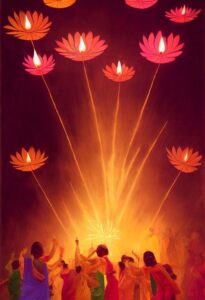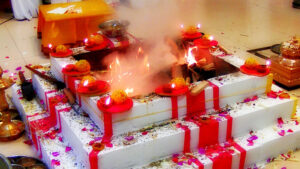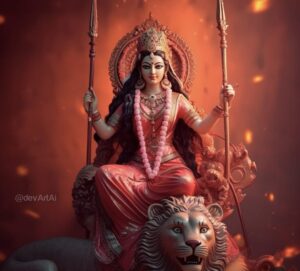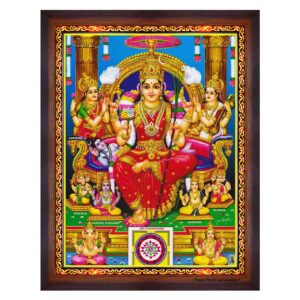Amid the vibrant festival of Navaratri, Goddess Lakshmi takes her divine place, gracing us with her captivating legend, resplendent presence and profound teachings. Her story, intertwined with the festival’s essence, falls on the auspicious day of Lakshmi Puja, which is celebrated with great fervor.
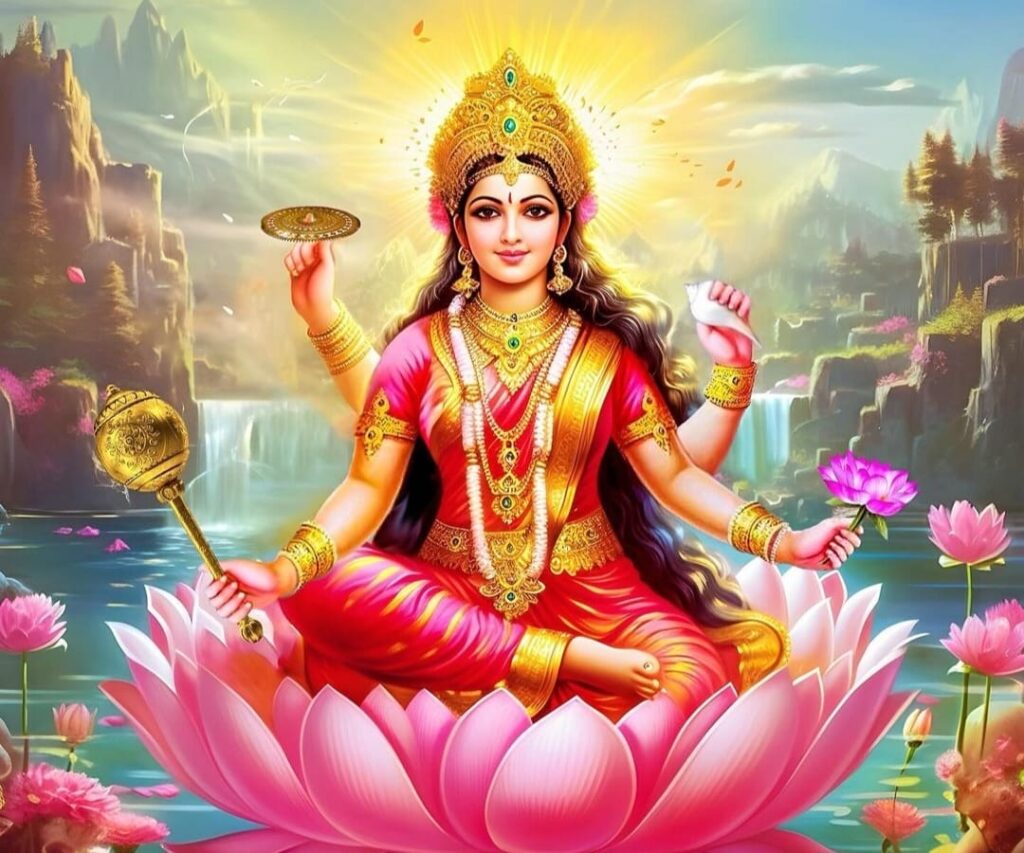
Day of Celebration: The day dedicated to Goddess Lakshmi according to South Indian tradition typically falls on the sixth day of Navaratri.
Story of Maha Lakshmi:
Lakshmi, the goddess of wealth and prosperity in Hindu mythology, has an enchanting origin story that weaves together elements of divinity and human nature. This timeless tale begins with a chance encounter between Sage Durvasa and Lord Indra.

Sage Durvasa, known for his irascible temperament and stern penances, once approached Lord Indra, the king of the gods. In a gesture of deep respect and reverence, the sage offered Lord Indra a fragrant garland of flowers. However, Lord Indra, in a moment of arrogance, decided to place the garland not around his own neck but on the forehead of his divine elephant, Airavata.
Airavata, the noble elephant, simply acted in accordance with his nature and discarded the garland by tossing it to the ground. Unbeknownst to him, this seemingly trivial act would set off a chain of events that would resonate through the heavens.
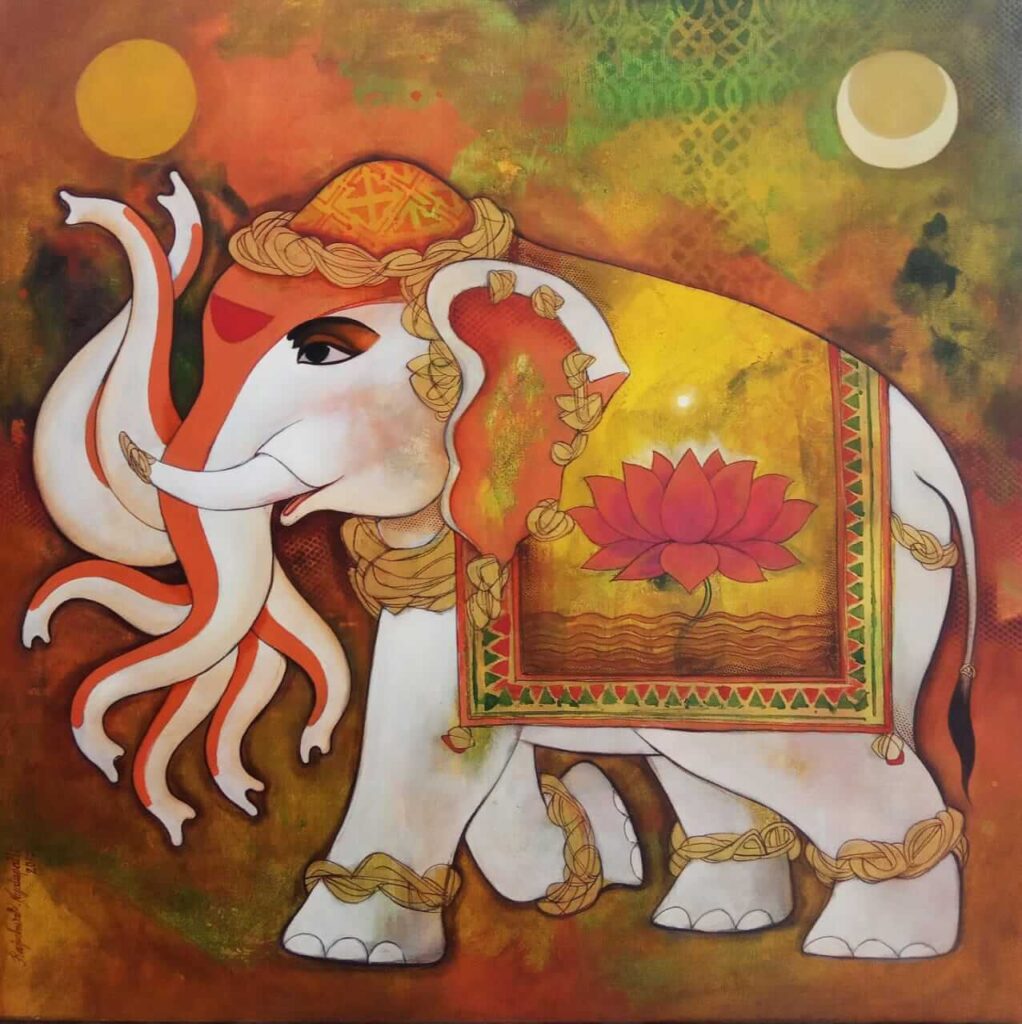
Sage Durvasa, feeling dishonored and slighted by this treatment of his gift, chastised Lord Indra. He declared, “Your pride and arrogance have led you to disrespect me.” In his anger, Durvasa cursed Lord Indra, prophesying the ruin of his kingdom as a consequence of this arrogance.
The aftermath of Durvasa’s curse unfolded rapidly in Lord Indra’s city. The gods and the people lost their vigor and vitality, crops and plants withered away, acts of charity ceased, impurity of mind became rampant and desires spun out of control.
As the gods grew weak and dispirited in Indra’s realm, the demons seized the opportunity to invade and conquer their heavenly abode, plunging everything into chaos. This cosmic tale symbolizes the eternal struggle between good and evil, with both residing within each of us.
In their weakened state, the gods sought the counsel of Lord Vishnu, the preserver of the universe. He proposed a solution: the churning of the primordial ocean to regain the lost power of the gods. This churning process would yield the elixir of immortal life, restoring the gods to their former glory.
The churning of the cosmic ocean took on a symbolically colossal form, a celestial tug of war between the gods and demons. With the aid of a massive snake coiled around Mount Mandara, which they sunk into the milky sea, both sides engaged in a Herculean struggle. The snake unraveled as they churned, causing the mountain to revolve and the primordial ocean to froth and surge.
From the tumultuous depths of the ocean emerged an array of treasures, including the radiant goddess Lakshmi herself, seated upon a blooming lotus. Her appearance was magnificent, fully grown and mesmerizing.
In a cunning twist of fate, the gods managed to secure the elixir of immortal life, restoring order to the universe. This narrative holds profound lessons, teaching us that arrogance and anger can lead to a life devoid of purpose, peace and strength.
Depiction:
Goddess Maha Lakshmi is typically depicted as a radiant and beautiful woman, adorned with royal attire and ornaments. Her appearance is often described as follows:
- Four Arms: Maha Lakshmi is depicted with four arms, symbolizing her divine powers.
- Golden Complexion: She is often portrayed with a golden or yellow complexion, signifying wealth and prosperity.
- Lotus: In two of her hands, she holds lotus flowers, which symbolize purity and spiritual liberation.
- Abhaya Mudra: One of her hands is in the Abhaya Mudra, a gesture of protection and fearlessness.
- Varada Mudra: Her fourth hand is in the Varada Mudra, a gesture of granting boons and blessings.
- Attire: She is adorned with royal clothing, which represents her status as the goddess of wealth and prosperity.
- Crown: Maha Lakshmi wears a crown studded with jewels, signifying her royal and divine nature.
- Seated on a Lotus: She is often seated or standing on a fully bloomed lotus flower, which symbolizes purity and transcendence over material desires.
The divine realm encompasses both Lakshmi and Maha-Lakshmi, each holding a distinct position and significance. Lakshmi is renowned as the consort of Lord Vishnu and is revered as the goddess of wealth and prosperity. In contrast, Maha-Lakshmi is perceived as an autonomous and supreme entity, representing the ultimate embodiment of the mother-goddess.
During Navaratri, it is Maha-Lakshmi, the supreme goddess, who is fervently worshipped. This choice reflects the deep reverence for the all-encompassing, nurturing and transcendent qualities embodied by Maha-Lakshmi. Devotees seek her blessings to attain spiritual enlightenment, inner peace and the fulfillment of their desires during this auspicious festival. The worship of Maha-Lakshmi during Navaratri symbolizes the pursuit of ultimate knowledge, abundance and divine grace.
Method of Worship:
- Meditation and Purity: Begin your worship by purifying your mind and body through meditation. Sit in a calm and quiet place, focus on your breath, and clear your mind of distractions.
- Set Up the Altar: Create a sacred space or altar with a picture or idol of Goddess Maha Lakshmi. Decorate it with fresh flowers, incense, and a clean cloth.
- Light a Lamp: Light a diya (lamp) or a ghee lamp in front of the Goddess to symbolize the dispelling of darkness and the arrival of divine light.
- Offerings: Offer white and yellow flowers, sweets (such as laddus or modaks), fruits, and a coconut to the Goddess as a symbol of devotion and prosperity.
- Chant Mantras: Chanting mantras is a powerful way to connect with the Goddess. Here are some mantras to recite:
Mantras to Chant:
- Maha Lakshmi Mantra:
- “Om Shreem Maha Lakshmiyei Namaha”
- Translation: “Om, I bow to the great Goddess Maha Lakshmi.”
- Kanakdhara Stotram:
- This stotram, composed by Adi Shankaracharya, is dedicated to Goddess Maha Lakshmi and is believed to invoke her blessings.
Prayer and Offerings:
- Close your eyes, focus on the Goddess, and offer your heartfelt prayers. Seek her blessings for wealth, prosperity, and abundance in your life.
- Offer the sweets and fruits to the Goddess, and then distribute them as prasad (blessed food) among your family members or friends.
- Light the incense and circulate it in a clockwise direction in front of the idol or picture.
- Conclude your worship with deep gratitude and a sense of devotion.
Remember to perform the worship with a pure heart and devotion. These mantras and rituals can help you connect with the divine energy of Goddess Maha Lakshmi, seeking her blessings for prosperity and well-being in your life during Navaratri.
Prasadam: Lakshmi, the Goddess of abundance and prosperity, is traditionally offered dishes like Kheer, Malpua and intriguingly, in some mythological accounts, offerings may include amla and even chillies as part of her worship.
In south Indian tradition a famous rice made dish Pulihora made with Tamarind also called Chintapandu Pulihora is offered to Goddess Mahalakshmi.

Devotees find it a perfect time to worship Goddess Laksmi during navaratri to seek her blessings related to wealth and prosperity not only in the material world but also in the spiritual realm.
Some more myths about Goddess Maha Laksmi:
Lakshmi, Saraswati and Ganga were originally the wives of Lord Vishnu in the divine realm of Vaikuntha. Saraswati began to feel that Lord Vishnu was favoring Ganga more and complained to Lakshmi. While Lakshmi remained neutral, Saraswati’s irritation grew and she cursed Lakshmi to transform into a tree due to her insensitivity. This act of cursing led to a chain of curses as Ganga felt that Saraswati was unjustly interfering and cursed her in return and Saraswati, in response, cursed Ganga. Reacting to these mutual curses, Lord Vishnu granted unique destinies to all three goddesses:
- Lakshmi would be born as a tree in the house of King Dharmadhwaja and later become the wife of Asura Shankhachuda, who was a devoted follower of Lord Vishnu. Eventually, she would regain her divine form and become Lord Vishnu’s beloved wife. She would also exist eternally as Tulasi, a sacred plant, and as the River Padmavati in Bharata Varsha.
- Ganga, influenced by Saraswati’s curse, would become a sacred river, purifying those who bathed in her waters. She would also flow into Bharata Varsha as the River Bhagirathi and become the consort of Samudra (the ocean). Simultaneously, she would continue to reside on Lord Shiva’s head.
- Saraswati, due to Ganga’s curse, would become the consort of Lord Brahma, the creator. Half of her divine essence would be in Bharata Varsha, while the other half would remain with Lord Brahma.
Upon receiving these destinies, all three goddesses realized their mistakes and embraced each other. They prayed to Lord Vishnu, who assured them that he would uphold the curses and continue to shower them with equal love and attention in Vaikuntha.
The mutual curses among these goddesses had a profound underlying purpose. They were meant to provide sacred rivers and holy pilgrimage sites in Bharata Varsha, where not only devotees of Lord Vishnu but even the gravest sinners and atheists could seek redemption. These sacred rivers and places were essential for the spiritual growth and purification of all beings, regardless of their past actions.
Lord Vishnu emphasized that Earth was burdened by individuals engaged in deceit, false promises, social exploitation and other negative actions. The emergence of sacred rivers like Ganga, Padma and Saraswati aimed to guide and reform such individuals, providing them with opportunities for self-improvement and redemption.
Not to confuse, some texts even say when Lakshmi sought to calm Saraswati’s wrath through dialogue, the envious goddess turned her ire towards Lakshmi herself. Accusing her of disloyalty, Saraswati cast a curse upon Lakshmi, condemning her to be reborn as the sacred tulasi plant on Earth.
Author,
Sivalenka Neeraja

